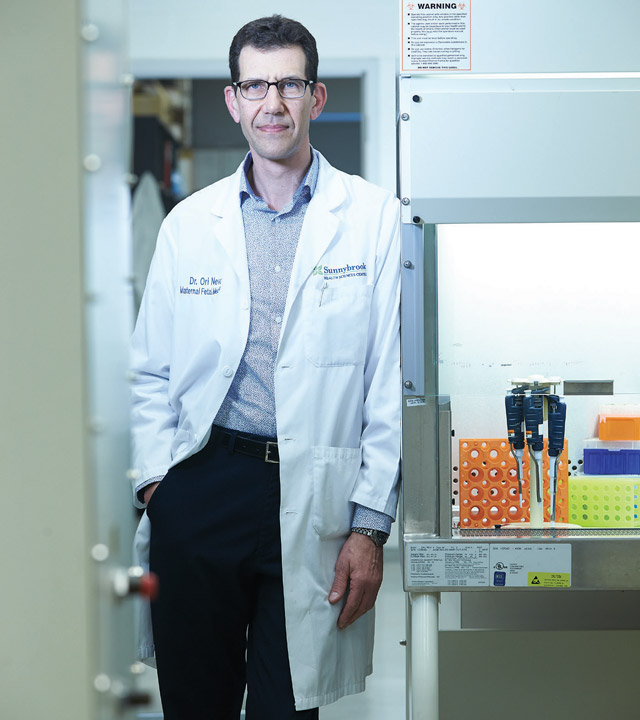Getting to the root of pre-eclampsia

Cells lining blood vessels offer clues to the origin of dangerous disorder
September 12, 2018

Dr. Ori Nevo aims to uncover the root cause of pre-eclampsia. He is studying gene expression of maternal endothelial cells, which line the inside of blood vessels.
In her 2010 memoir, Spoken From the Heart, former U.S. First Lady Laura Bush wrote about a scare during her pregnancy with her twins. During the third trimester, her blood pressure became dangerously high and her kidneys began to fail, causing her doctor to order an emergency caesarean section. Her daughters, Barbara and Jenna, were born five weeks early, putting them at risk for a host of problems, including infections of the lung and brain, poor vision, hearing loss and chronic lung disease.
Her story is one of several high-profile accounts that has raised awareness of pre-eclampsia, a pregnancy complication that is characterized by very high blood pressure and too much protein in the urine, a sign that the kidneys are not working properly. It develops in the second half of pregnancy, usually after the 20th week. Symptoms include sudden weight gain, swelling, headaches and changes to vision. Left untreated, the condition can be devastating, damaging the liver, kidneys or brain in mothers; it is also associated with smaller babies and results in premature birth since the only cure is delivery.
About 10,000 pregnant women in Canada are affected by pre-eclampsia each year. According to the World Health Organization, pre-eclampsia is a leading cause of illness and death in women and babies. It estimates that between 62,000 and 77,000 maternal deaths are due to pre-eclampsia and other hypertensive disorders each year. The Preeclampsia Foundation notes the condition is responsible for 2.6 million preterm births and 500,000 infant deaths worldwide each year.
“Women with pre-eclampsia might have an underlying cardiovascular disorder, but many of them are considered to be completely healthy before they develop it. These women, for mostly unknown reasons, develop an abnormal placenta, which causes pre-eclampsia later in the pregnancy. In most cases we do not know why they develop an abnormal placenta; sometimes it just happens, or it could be associated with a clotting disorder, unusual immune response, genetic issues or multiple factors,” says Dr. Ori Nevo, a scientist in the DAN Women & Babies Research Program at Sunnybrook Research Institute (SRI), and maternal-fetal medicine specialist at Sunnybrook.
Despite its prevalence and long history—it’s believed that Hippocrates was the first to describe the complication in 400 BC—its exact cause is unclear. It is also called “the disease of many theories,” owing to numerous ideas about its origins. Nevo is trying to pinpoint its biological genesis. He is the first to analyze maternal endothelial cells, which line the inside of blood vessels, to see if they function differently in women with pre-eclampsia. Why study them? This layer of cells acts as a barrier between the blood and body tissue, while selectively allowing chemicals and white blood cells to move between them. Researchers have shown that endothelial cells play an important role in maintaining the health of the circulatory system; they release substances that control the formation of new blood vessels, relaxation and contraction of vessels, blood clotting and immune function.
After getting consent, Nevo obtained samples from healthy women and women with pre-eclampsia. “We take little samples of fat tissue during a C-section. We have a method of isolating endothelial cells from those samples, and we grow the cells in a dish and see how they behave,” he says. He notes that while there are placental tissue banks for research, the bank of maternal endothelial cells he has created at SRI is unique.
He specifically wanted to know whether the endothelial cells of women with pre-eclampsia express the same genes related to blood vessel function as those of healthy pregnant women. “We found differences in several genes that participate in normal vascular function. After several weeks of growing in the dish, those cells are still functioning abnormally. We showed for the first time that the endothelial cells [of women with pre-eclampsia] are abnormal, probably because of the preeclampsia,” says Nevo. The study was published in the American Journal of Physiology-Heart and Circulatory Physiology.
In particular, he observed that gene expression associated with high blood pressure was exponentially higher in the pre-eclamptic samples. Moreover, there was decreased expression of genes associated with relaxation of vessels. Nevo says the results could provide insight into the risk of cardiovascular disease after pre-eclampsia. Even though blood pressure often returns to normal after delivery, women with preeclampsia are not out of the woods. A 2007 study published in the British Medical Journal showed these women have almost four times the risk of developing high blood pressure and double the risk of heart disease and stroke. “We know these women have long-term cardiovascular issues and their vessels are not responding as well. What we see might explain those long-term issues,” he says.
Nevo has also looked at the effects of certain drugs on gene expression in maternal endothelial cells. One is magnesium sulfate, which is used to prevent seizures in women with pre-eclampsia. The drug worked differently in the endothelial cells of pre-eclamptic women. Here, magnesium sulphate decreased the expression of substances that cause blood vessels to constrict and that hinder the growth of new blood vessels. That the endothelial cells of women with preeclampsia respond well to magnesium, which dilates blood vessels, suggests there is an intrinsic deficiency in these cells, state Nevo and colleagues in a paper published in the Journal of Hypertension in Pregnancy.
Next, he will test the use of drugs to lower cholesterol to see if they reverse abnormal gene expression in endothelial cells of women with pre-eclampsia. He will also investigate how the endothelial cells interact with perivascular cells, the smooth muscle cells that surround blood vessels. The ultimate aim is to find more therapies. Pre-eclampsia is treated with drugs to lower blood pressure or magnesium sulfate to prevent seizures. They are given so that the pregnancy can continue longer. Some blood pressure medications, however, are unsafe in pregnancy, and magnesium, administered intravenously, is only given once a woman is admitted to hospital.
Bush did everything she could do to prolong her pregnancy, including following the doctor’s orders putting her on bed rest at seven months. She was fortunate that she and her daughters had no further health issues following her bout with pre-eclampsia, but as the statistics show, that is not the case for thousands of women and their babies each year. Detecting the condition as soon as possible is critical to managing the illness before it becomes life-threatening, necessitating the emergency surgery that Bush had. So, too, is finding better treatments, which rests in unravelling the biological basis of the disease. As Nevo’s research suggests, the cells embedded in the life-sustaining blood vessels that nourish mother and child could hold the answer, a mystery he is tackling one batch of cells at a time.
Nevo’s research was supported by the faculty of medicine at the University of Toronto, and theDAN Women & Babies Program at Sunnybrook.



